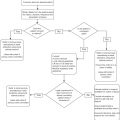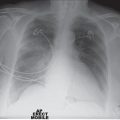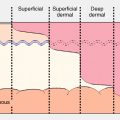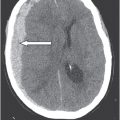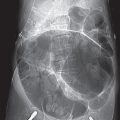Chapter 19
Stroke and transient ischaemic attack
Introduction
The consequences of acute stroke can be devastating for a person’s independence, cognitive function and quality of life. Patients aged over 80 have a higher mortality and more frequent complications, particularly pneumonia, following acute ischaemic stroke than their younger counterparts. The increased rate of complications is likely due to a more dependent pre-morbid state and more complex comorbidity.
Until recently, there has been very limited information on the benefit of specialist interventions such as thrombolysis and carotid endarterectomy in older patients; however, emerging evidence supports the proactive management of stroke and stroke risk factors in appropriately selected older patients.
This chapter is designed to help junior staff initially assess patients presenting with a stroke or transient ischaemic attack (TIA), provide information on current opinion on carotid endarterectomy and thrombolysis in older people and also provide guidance on the initiation and management of patients on newer anticoagulant agents.
Definition
Stroke
Stroke is defined as ‘a clinical syndrome, of presumed vascular origin, typified by rapidly developing signs of focal or global disturbance of cerebral functions lasting more than 24 hours or leading to death’ (1). 85% of strokes are ischaemic in origin, 10% are due to intracerebral haemorrhage and 5% are due to subarachnoid haemorrhage.
Transient ischaemic attack (TIA)
TIA was traditionally defined as an acute loss of focal cerebral or ocular function with symptoms lasting less than 24 hours, thought to be due to inadequate cerebral or ocular blood supply as a result of low blood flow, thrombosis or embolism associated with diseases of the blood vessels, heart or blood (2). However, owing to concerns that the arbitrary 24 hour time period may result in confusion and delays in administering time-sensitive stroke therapies, a revised tissue-based definition has been adopted. This definition is less dependent on any specified time periods and focuses more on the pathophysiological entity of transient rather than permanent ischaemia. This new approach to the condition defines TIA as ‘a transient episode of neurological dysfunction caused by focal brain, spinal cord, or retinal ischemia, without acute infarction’ (3).
Background
Over 30% of acute strokes occur in patients over the age of 80, and considering the rising population of octogenarians and nonagenarians, prompt and thorough management of stroke and its risk factors in older people could confer significant reductions in morbidity and mortality (4).
A stroke or TIA is a cerebrovascular emergency and older patients can derive relatively greater benefit from early treatment compared to their younger counterparts (5). The days of the ‘watch and wait’ approach are gone, and further research into the treatment of acute stroke has led to thrombolysis being offered to patients aged over 80. The management of stroke in older people is an exciting and rapidly developing field.
Stroke has varied clinical presentations depending on anatomical location but is usually associated with the rapid onset of a focal neurological deficit. The classification presented in Table 19.1, based on anatomical pathophysiology, is widely used. It allows classification on clinical grounds, and the subtypes described have prognostic value.
Table 19.1 Stroke subtypes by location, presenting symptoms and prognosis (Oxford classification)
| Stroke type | Anatomical pathophysiology | Clinical features | Mortality at 30 days (%) |
| Lacunar infarct | Intrinsic disease of a single basal perforating artery, most commonly in the basal ganglia, internal capsule or pons |
Owing to the high concentration of motor fibres in the internal capsule, a small lacunar infarct in this region can cause a large motor deficit | 2 |
| Total anterior circulation infarct | Ischaemia of both the deep and superficial territories of the middle cerebral artery | Combination of:
| 39 |
| Partial anterior circulation infarcts | Occlusion of either the upper division of the MCA (therefore usually no visual field defect) or the lower division of the middle cerebral artery (usually a negligible motor/sensory component) Occlusion of the anterior cerebral artery and striatocapsular infarctions | Two of the three components of the TACI syndrome with:
| 4 |
| Posterior circulation infarcts | Infarcts associated with the brainstem, cerebellum or occipital lobes | Any of the following:
| 7 |
LACS, Lacunar infarct; TACS, total anterior circulation infarct; PACS, Partial anterior circulation infarcts; POCS, posterior circulation infarcts.
Source: Table compiled using excerpt from Bamford et al “Classification and natural history of clinically identifiable subtypes of cerebral infarction.” Lancet. 1991 Jun 22;337(8756):1521–6. With permission from Elsevier.
Stroke categorisation
Symptoms which may suggest alternative pathology
- Delirium with no focal neurological signs: usually suggests global rather than focal brain dysfunction such as infection or metabolic derangement.
- Seizure: may present as a postictal state with focal neurological signs, such as Todd’s paresis; remember that occasionally a seizure can be a complicating feature of stroke.
- Loss of consciousness (LOC): unless associated with significant haemorrhage and intracranial oedema. Rarely a posterior circulation stroke can present with LOC or locked-in syndrome.
Stroke mimics
Conditions which can lead to diagnostic error by mimicking acute stroke include (6):
- Seizure and post-ictal state
- Syncope
- Complex migraine or ocular migraine
- Hypoglycaemia or electrolyte disturbance
- Brain tumour
- Exacerbation of pre-existing neurological deficits by a systemic process (e.g. temporary reappearance of old stroke symptoms)
- Bell’s palsy
- Vestibular disorders (however, posterior circulation stroke and vertebral artery dissection should be considered)
Initial assessment of patients with acute stroke in the ED
Rapid initial assessment is an essential part of managing acute stroke (Table 19.2), and a focused ABCDE examination should be performed to ensure that the patient is not medically unstable so that an urgent CT brain can occur within minutes of the patient’s arrival in the ED. General observations and a record of conscious level using the AVPU score and capillary glucose should be performed as part of this initial assessment.
Table 19.2 Recommended timescale for assessment and management of patients presenting with acute stroke
| Action | Time |
| Door to physician | ≤10 min |
| Door to stroke team | ≤15 min |
| Door to CT initiation | ≤25 min |
| Door to CT interpretation | ≤45 min |
| Door to drug (≥80% compliance) | ≤60 min |
| Door to stroke unit admission | ≤3 h |
Source: From Jauch EC, Saver JL, Adams HP Jr, Bruno A, Connors JJ, Demaerschalk BM, Khatri P, McMullan PW Jr, Qureshi AI, Rosenfield K, Scott PA, Summers DR, Wang DZ, Wintermark M, Yonas H; Guidelines for the early management of patients with acute ischemic stroke: a guideline for healthcare professionals from the American Heart Association/American Stroke Association. Stroke. (12);44:870–947. With permission from Wolters Kluwer Health.
Training for paramedics and ED staff in the use of stroke screening tools is widely available and associated with increased sensitivity in initial diagnosis. The FAST test and the ROSIER score can enable the diversion of patients to appropriate stroke centres and allow appropriate triage of potential stroke patients arriving in the department.
The FAST test
This is used to aid pre-hospital recognition of stroke by the general public and emergency services providers, and can also be used in the ED to aid the rapid initial assessment of acute stroke symptoms:
- Face: Ask the patient “show me your teeth” to look for facial asymmetry
- Arms: “Raise both arms” to look for pronator drift over 10 seconds
- Speech: “repeat after me: ‘baby hippopotamus’ ‘British constitution’” to assess for dysarthria
- Time: Establish time of onset from the patient or a witness.
Recognition of stroke in the emergency room (ROSIER) Score
This is one of several useful screening tools developed to assist ED staff in assessing the patient presenting with symptoms of stroke.
Time of onset
This is crucial; particularly if considering thrombolysis, which is currently given up until 4.5 hours after symptom onset in patients aged under 80 and up to 3 hours after symptom onset in patients aged over 80. Some patients may be unable to provide a history; therefore, a witness account should be urgently sought. If the time of onset is unclear, it must be taken as whenever the patient was last seen well; if the patient awoke with the symptoms, time of onset is when they went to bed.
Once a rapid initial assessment has taken place and necessary scans organised, further information should be gathered as follows:
Past medical history
This should be documented, with particular focus on any previous vascular or intracerebral events. Prior neurological impairments should be recorded. Particularly relevant non-stroke conditions include epilepsy, malignancy, dementia, diabetes and risk factors such as ischaemic heart disease and atrial fibrillation.
Functional status
Functional status and pre-morbid level of independence are relevant when making decisions about thrombolysis. Factors such as nursing home residence and extreme dependence should be considered, although decisions are often made on an individual basis considering patient and family values and a review of the associated risks and benefits. Pre-morbid function is helpful when trying to predict longer term outcomes and rehabilitation goals.
Medications
Drug history should be noted with particular attention paid to warfarin use and INR (this should be checked urgently on arrival), anti-platelets, novel anticoagulants and antihypertensive medications.
Examination
General examination
Once brief initial assessment has occurred and the patient is in the CT scanner, further information can be gathered from the family, the stroke team can be involved early and the patient can undergo a more detailed neurological examination.
All patients with a suspected stroke should have a full neurological assessment, preferably incorporating the National Institute of Health Stroke Scale (NIHSS) and an assessment of coordination and higher cortical function.
Systemic examination should aim to identify precipitating causes of stroke such as atrial fibrillation, bacterial endocarditis or carotid stenosis. The patient’s pulse, oxygen saturations and blood pressure should be closely monitored. Extreme hypertension or hypotension should be identified.
The national institute of health stroke scale
This is a 15-point neurological scale that aims to provide a quantitative assessment of the neurological status of patients who have suffered an acute stroke. The scale assessment takes less than 10 minutes to perform but requires specific (though simple) training before it can be carried out.
Recommended resources
There are many useful online resources that provide ED staff with information and resources to support them when managing patients with acute stroke.
- The NIHSS online training module: http://learn.heart.org/ihtml/application/student/interface.heart2/nihsscomputer.html#3
- Stroke Track app which is downloadable free from iTunes: https://itunes.apple.com/gb/app/stroke-track/id378682166?mt=8
- http://www.strokeassociation.org provides free online education modules.
Higher function assessment
Dysphasia
Stay updated, free articles. Join our Telegram channel

Full access? Get Clinical Tree



